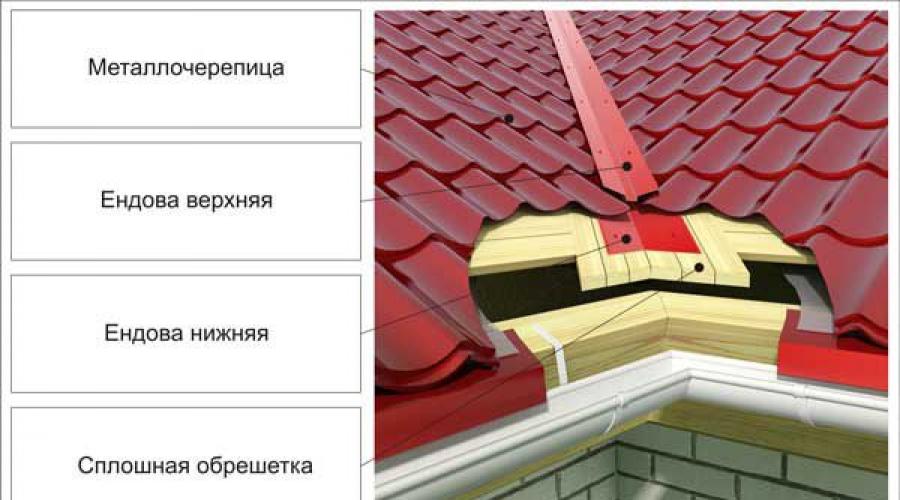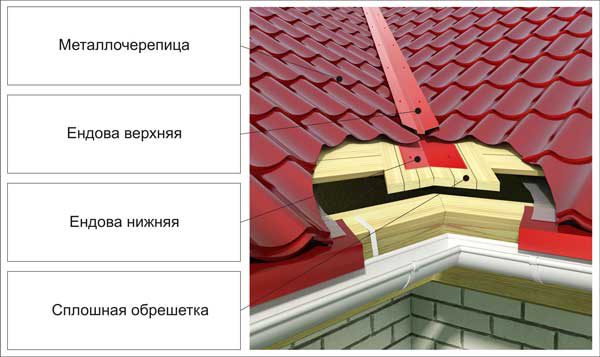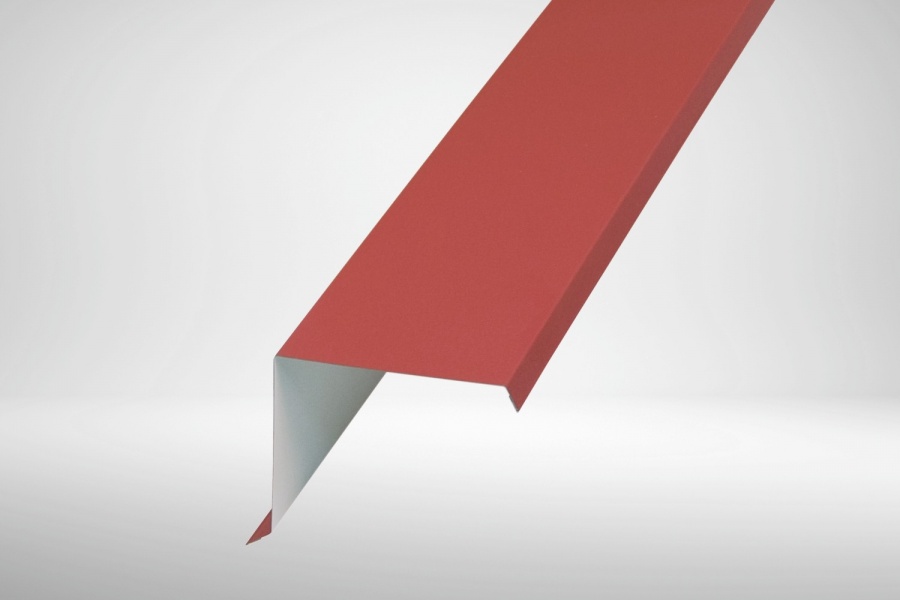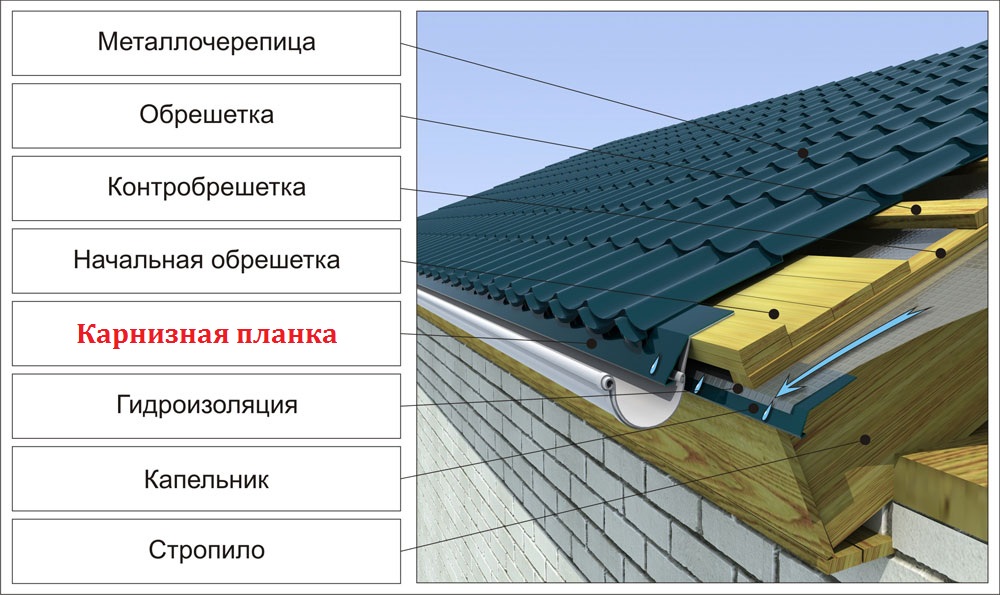Overview of additional elements for the installation of metal roofing

In order for a roof made of a modern metal profile to have a neat and finished look, it is necessary to purchase components for a metal tile in advance. These are all kinds of corners, skates and other elements. The components not only make the coating a single whole and perform a decorative function, but as a result prevent moisture, debris and dust from getting between the profile sheets, forming strong roofing units from metal tiles. So, they prevent the destruction of the entire roof over time. About the types of additional elements and their purpose on the roof in the material below.
Types of accessories for metal tiles
Skate
If you are interested in metal roofing elements, then you should know that the very first of them is a ridge bar. Such an element is designed for joining two roof slopes at an angle and in the same plane. That is, the ridge forms a logical completion of the roof in its uppermost part.
Modern profile manufacturers offer a ridge bar of the following forms:
- Radius skate (semicircular). In most cases, it is used on a metal roof. It can have a radius from 70 to 125 mm.
- Trapezoidal skate. It is universal and can be used on any roofs.
- Figure skate. Also perfectly harmonizes with any other roofing material.
Important: for a figured and trapezoidal ridge, the extension of one wing can vary between 150-300 mm, depending on the configuration of the roof and the slope of the slopes. Moreover, regardless of the shape of the ridge, its length is always 2 m.
However, the ridge is not the only main element of the peak part of the roof. To fully complete the ridge knot, you need to purchase the following components:
- T-piece and Y-piece. The first is necessary for connecting ridge slats on a four-pitched roof, and the T-shaped one is designed for perpendicular connection of hip roof slats.
- Cap for ridge rail. Such an element applies only to a semicircular ridge. In this case, the plug can have a flat, conical or tented appearance. These plug nets prevent the penetration of birds, as well as debris or dirt into the existing under-roof space.
- Sealant-substrate for metal roofing. Provides a tighter fit of the metal profile to the roof and prevents it from rattling in the wind. In addition, it performs a waterproofing function.
endova

Such an element of a metal tile is necessary if the roof has a broken configuration. Valley planks are laid in the inner (negative) corners of the roof. Such a fragment of the roof is designed to take on the flow of precipitation from two adjacent roof slopes and divert them freely into the drainage system. The valley has the form of a plank bent at an angle inward. There are such types of valleys:
- Internal (lower). Designed for laying directly on the crate before mounting the profile sheet. That is, it must be placed under the metal tile. After the installation of the roof, it will not be visible. At the same time, it is important not to forget that when fixing the lower valley, a substrate under the metal tile should be used.
- External (upper) valley. It is installed on top of an already mounted roof and performs a decorative function. It has the same configuration as the internal additional element for a roof made of metal.
- Figured valley. Acts as an upper bar, but at the same time has an attractive appearance. Precipitation flows along it to a lesser extent than along the lower fragment.
Important: like the ridge, the valley plank has a standard length of 2 m.
end plate

Often it is also called a wind bar. Such a fragment is attached from the gable part of the roof along the ends. As a rule, the wind bar has the form of a profile sheet bent along the length. The main function of the end plate is to protect the roofing material from possible failure under gusts of wind. In addition, the wind bar protects the under-roof space from the penetration of birds into it and at the same time performs a decorative function. The length of the overhangs of such a bar can vary from 10 to 25 cm. At the same time, the length of the bar itself is unchanged - 2 meters.
Tip: to visually complete the roof space, you can buy both a smooth wind bar and a more attractive embossed one.
dropper
Such a fragment, together with a cornice strip, forms a complete cornice assembly. The dropper is mounted on the gable board of the truss system / crate in order to prevent water drops from falling onto the tree when rainwater descends into the drainage system. The standard dimensions of the dropper are 40-50x100-110 mm with a length of 2 meters.
eaves plank

This piece for a metal roof is also indispensable in the overall construction of the roof. In its form, this is a kind of ebb with a bend on it. Such a bar additionally protects the cornice boards from excess moisture and is mounted on a drip film. As a rule, the cornice plank has the following parameters of the cornice wing - 70x100 mm or 100x150 mm. The length of the product is also 2 meters.
Adjoining strips
Such roofing accessories allow you to combine roofing and protruding elements on the roof, such as chimneys, protruding turrets, and so on, into a single structure. The junction bar prevents water from getting between the metal tile and the protruding roof fragments. In addition, such an element performs a decorative function, forms a roofing space that is uniform in color and shape.
Snow guards
![]()
It is worth knowing that for a metal tile, the components listed above do not end there. Such a fragment as a snow retainer is no less important. Its main function is to delay the sudden sliding of snow layers along the tiles to the eaves during its seasonal icing over time. Since the snow crust can turn into a slightly icy crust under the sun, its sudden descent from the roof during some melting can cause damage to both the profile itself and the drainage system. That is, roughly speaking, if a block of ice moves off the roof, this will not bring any benefit to the roof.
According to the form of execution, such elements for metal tiles can be:
- Dotted. They can be placed on the roof in a checkerboard pattern over the entire surface of the roof.
- Trellised. Simple trellised snowplows are mounted at the bottom of the ramp.
- Tubular. They are placed in one line in the lower third of the roof slope.
Tip: you should not save on additional elements for a roof made of metal. Coating nodes that are not technically completed will eventually lead to the destruction of the entire coating. And this is a more significant cost than buying components for the roof.